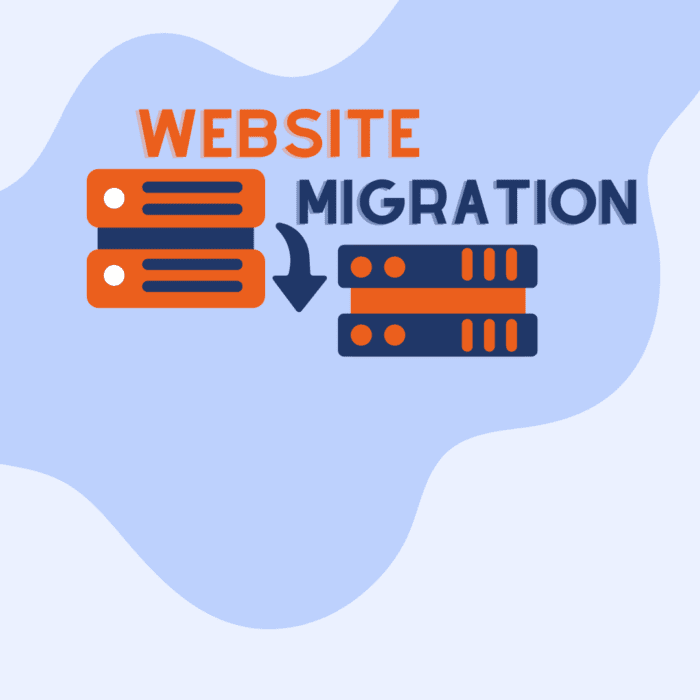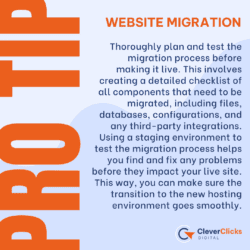What Is Website Migration?





By Sam Read
Digital Marketing Executive
Sam has 6 years of digital marketing experience, starting as an apprentice and building on his Fashion Marketing degree. He specialises in SEO, content, and design.
2 May 2024
Blog SEO Web DevelopmentWebsite migration encompasses a spectrum of changes, from relocating to a new server or domain to adopting a fresh design, adjusting content, restructuring key elements, or transitioning platforms or CMS. This transformative process may also prioritise enhancing user experience (UX) or implementing CRO updates.
Despite its potential benefits, even seemingly minor migrations can significantly impact organic traffic if not strategically planned and executed. Therefore, a comprehensive understanding of the website migration process is imperative for website owners seeking a seamless transition while maintaining or improving their search engine visibility and rankings.
Whilst experienced SEO specialists can navigate a migration with minimal impact, a Twitter Poll by Natalie Slater featured on SE Round Table shows that almost 80% of SEOs expect to see some traffic loss following a site migration – even if it’s minimal and temporary.
Rebranding: Businesses often undergo rebranding efforts to realign with their evolving goals and market positioning. Updating the website to reflect the new brand identity may also include migration to a new domain name or redesigning the website on a different platform.
Website Redesign: In the rapidly evolving digital landscape, periodic redesigns are essential to keep pace with changing user expectations and technological advancements. When a new version of the website is developed, migrating it to replace the old version becomes a crucial step in ensuring continuity and improvement.
Platform Upgrades: As technology progresses, website owners may find it imperative to upgrade their website platform to leverage new features, enhance performance, or improve security measures. This could involve migrating from an outdated content management system (CMS) to a more modern one or transitioning to a platform better suited to their evolving needs.
Upgraded Hosting: Suboptimal website performance, frequent downtime, or inadequate customer support from the current hosting provider can prompt website owners to seek new hosting services. Migrating to a new hosting provider offers the opportunity to enhance website performance, reliability, and user experience.
Expanded Functionality: As businesses grow and evolve, their website requirements may outgrow the capabilities of their current platform or infrastructure. Migrating to a more robust platform or architecture enables the integration of advanced functionalities and scalability to accommodate future growth.
SEO Optimisation: Strategic website migration can be a crucial aspect of SEO optimisation efforts. Consolidating content, implementing structural improvements, or rectifying technical issues through migration can positively impact search engine visibility, organic traffic, and overall website performance. However, poorly managed migrations can have huge impacts on search traffic, according to Moz’s Website Migration Guide, even a simple migration like a switch from HTTP to HTTPS caused a leading UK retailer’s visibility to drop by 35%, taking them 6 months to recover from.
Compliance Requirements: Changes in legal regulations or industry standards may require modifications to the website infrastructure or content. Migrating the website to align with updated compliance requirements ensures adherence to legal obligations and mitigates the risk of penalties or legal issues.
Mergers or Acquisitions: In the event of mergers or acquisitions, consolidating several websites onto a single platform or domain streamlines operations, enhances brand consistency, and facilitates cohesive customer experiences. Website migration plays a vital role in the integration process, ensuring seamless transition and synergy between entities.


SEO Impact: Updating your website’s structure or moving pages can cause rankings to drop if not done correctly. To avoid this, set up proper redirects and update all internal links so search engines and users can find your pages easily. According to Google’s Search Central guidelines, implementing 301 redirects and updating internal links are crucial steps in preventing traffic loss during a migration.
Website Downtime: If your website is down during migration, customers won’t be able to access it, which could lead to lost sales. To avoid this, Google recommends running migrations during off-peak hours and testing changes in a staging environment to minimise disruption to users and potential traffic losses.
Data Loss: Mistakes or technical errors during migration can lead to the loss of critical website data, including content, customer information, or transactional records. Implementing robust backup procedures, conducting regular data integrity checks, and performing comprehensive testing before and after migration are essential to prevent data loss incidents.
Technical Issues: During migration, some features may break, or parts of your website might not work as expected due to software conflicts. Testing everything in advance and having a tech team ready to fix issues quickly will keep things running smoothly.
User Experience Impact: If your site’s design or navigation changes too much, visitors may struggle to find what they need, leading to frustration and drop-offs. For example, if you move key menu items or change URLs without redirects, returning users may feel lost. Transparent communication, user-centric testing, and providing support channels for feedback and assistance are essential for maintaining a positive user experience throughout the migration process.
Reputation Damage: Extended downtime, data loss incidents, or persistent technical issues can tarnish the website’s reputation and user trust. Timely communication with stakeholders, proactive issue resolution, and transparent updates on the migration progress are vital for preserving the website’s credibility and mitigating potential reputation damage.
Security Vulnerabilities: During migration, the website may become susceptible to security vulnerabilities, exposing sensitive data to potential breaches or cyberattacks. Implementing robust security measures, conducting security audits, and ensuring adherence to best practices for data protection are imperative to safeguard the website and user information throughout the migration process.
Legal and Compliance Risks: If your website doesn’t meet legal or industry standards after migration, you could face fines or damage to your reputation. To prevent this, check regulations before making changes and consult an expert if needed.
By acknowledging and addressing these risks and challenges proactively, businesses can navigate the website migration process successfully, minimise potential disruptions, and safeguard their online presence and reputation.
Website migration isn’t just about moving things around—it’s about improving your site for the future. With the right plan, you can keep your traffic steady and even boost performance after migration. Whether it’s a change in domain names, platforms, or hosting providers, meticulous planning and execution are paramount for a seamless transition.
Understanding the reasons behind your migration and the different types available empowers you to make informed decisions. Embracing best practices such as stakeholder communication, robust backups, thorough testing, vigilant monitoring, and expert guidance ensures smoother sailing during the migration journey.
Despite the inherent risks, such as potential SEO impact and downtime, the rewards of improved performance, enhanced scalability, and alignment with evolving business needs make migration a strategic choice. With proper preparation and strategic guidance, website migration becomes not just a necessity but an opportunity to elevate your online presence.
Ready to embark on your website migration journey? Engage with our specialist team for tailored SEO migration and web support to navigate the challenges and maximise the benefits of your migration. Let us help you to take your website to the next level, without compromising what you’ve already achieved.

Compare costs, expertise, flexibility, and results to find the best fit for your business.
Read full blog
Discover the key elements of a good website, from fast loading speeds and responsive design to clear navigation, engaging content and strong SEO foundations.
Read full blog